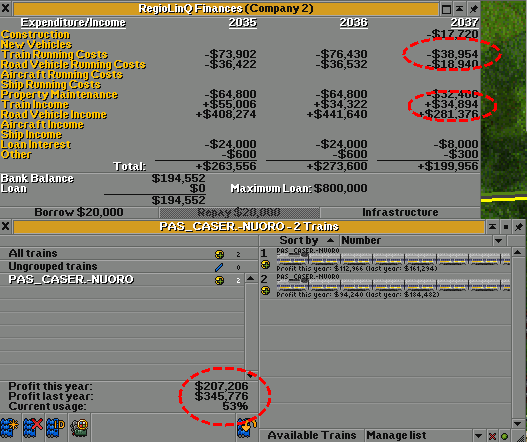
There are surely other ways to do it, but this way saves me the headache of having to think too far ahead, and gives you a pretty accurate picture at any time where you should be carting your passengers to. In the end, the passengers get to their Via stops, and from there are picked up by the next vehicle onto their next Via stop, or eventually, their Destination stop. And this of course between the most popular Via stops. Looking at their Via (again) tells you exactly where to cart them to next.Ĭombined with this, my vehicles usually take passengers only between two stops. I find if you plan your routes by Destination sometimes it's difficult to imagine the route that the passengers want. The reason I choose Via-Destination-Source, rather than say Destination-Via-Source as I used to, is because the first click shows me exactly what next station the passenger needs to be at.
Openttd cargodist plus#
Another level of the yellow plus sign, you'll get their Destination etc.) In Manual, Cargo is what you, as a Transport company, transport (relocate) between cargo agents. (When you click the yellow plus sign beside the passengers/mail, you'll get their Via station. For a listing of cargo types, see the Cargo category. So for example, say you have Stations A, B, C and D, and you have a train route that goes through A, B, C but no connection to D from either of the previous stations, then you may see. I've experimented with dynamic_casting and using pointers in my map, but from other answers I've seen, this doesn't seem to be a particularly good way to do it.Not really a setting, but on the cargo window I always choose "Via-Destination-Source" on the top right hand side. Enabling Cargodist will help - it will create demand for cargo/pax/mail at other stations as long as you have an established network to reach those stations. I'd love to hear what others would think the best way to approach this problem would be. I've been trying to use open source projects like OpenTTD and some of the Habbo Hotel emulators to figure all of this out, but to no avail. My first test was going to be to be able to place items on the map and then be able to query the sum of, say, all of the capacities of the container objects - just to make sure it works before moving on to the next step. I haven't fully scoped out the game yet, so at the moment I was just giving different objects different member variables - such as a container object that has a capacity, a heater object that has an energy rating, and so on. It was implemented in pull request 8688, for those who want to see the development history.This is the one change in version 12 that has by far caused the most questions everywhere, so let’s talk a bit more about it, and show some examples of simple. I had (wrongly) assumed that I would be able to have some sort of heterogenous container for all objects on the map, which I could loop through and run object-type-specific logic during the game loop. In OpenTTD version 12, we changed rail signals building UI only shows the Path Signal types by default.
Openttd cargodist full#
If you don't feel up to writing full articles then this may be a better place to start. The + icon in the station's cargo view also is not indicative of cargodist being active but it's just an indication that there is cargo waiting from more than one source that can be achieved via transfer orders without cargodist as well. Some articles need smaller changes to satisfy our needs, and there is a list of these.

Openttd cargodist manual#
Feel free to start editing as soon as you feel you can, but read the Manual of Style first. Server, Clients, Companies, Version, Host, NewGRF, GS, Password. All of this, while maybe not being the best approach, works, until I try to subclass Objects to give them different functionality. The OpenTTD documentation is stored and edited using this wiki. This modifies how many days the script for calculating distribution is allowed to run.
I have been able to create and render objects (like a table) using a fairly clunky debug class, contained within the Map class as a std::map and giving Objects X/Y coordinates so the Map can render them in the right places. Settings -> Environment -> Cargo Distribution The settings you want to look at are: TakeI have successfully implemented ground tiles and drawing them, et cetera, using a Tile class (held inside a Map class), but I would like to now be able to add objects on top of tiles. MyMap->func() // get the overloaded versionįor the last few weeks, I've been trying to develop an isometric, tile-based tycoon-style crafting game in my spare time (and really only to see if I am capable) and I have run up against a design challenge that I am struggling with.


 0 kommentar(er)
0 kommentar(er)
